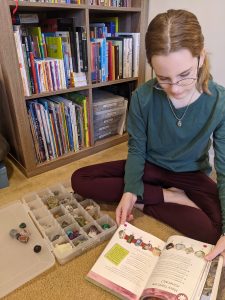Strewing in Your Homeschool
No matter what style of homeschooling you subscribe to, strewing is an effective means of engaging your children in self-directed learning and discovery.
Strewing is the art of casually leaving items around your house for your kids to pick up, engage with, and discover. An assortment of seashells with a magnifying glass, a history or current events magazine, a book of paintings, a small glockenspiel—all of these are perfect examples of things to leave out where your child might find them and spend time in exploration.
Strewing is intentionally child-led; if you point out the object(s) to your child and invite them to use it, it is no longer strewing. The power of strewing is that it puts the experience directly in your child’s control. They get to satisfy their natural curiosity and grow through an organic learning experience. Rather than having knowledge fed to them, they are feeding it to themselves. Only step in if they ask for assistance. It often requires patience on your part, as your child might not interact with the strewn items for several days. And there’s always a chance that they’ll be completely disinterested. Take that as your “feedback” and put the items away to try again another time. Interests change. Children mature. Critical thinking skills develop.

“So, let me get this straight—if I just leave the house a mess and don’t have the kids pick up their toys, I can count that as strewing?” No, it’s not quite that simple. The objects you strew and the way you leave them should be purposeful. Consider your child’s interests as well as their exposure to various disciplines. Consider where they hang out, where they decompress, and where they get creative. The set-up should be casual but inviting.
There are online lists of hundreds of things to strew, but some of my favorite things are a pocket microscope and a set of prepared slides. If I leave those on the coffee table, it takes less than a week for the kids to be into them. Then come the comparisons, the analyses, the Google searches for what they are looking at, and the rabbit hole discussions that are a homeschool parent’s delight.
We are big gameschoolers in our house, and I love to strew board and card games. I try to choose games without a lot of set-up, like Paint Chip Poetry, Boggle, Farkle, Tenzi, Top Trumps, or Scrambled States and place them on the kids’ school table. Sometimes a deck of cards or a set of dice is all it takes to unleash imagination and the kids will start devising their own games and rules.
Art and craft supplies are wonderful for strewing. You could leave a variety of inspiration pictures out along with supplies. Think outside the typical markers and paper to beading, yarn, dowels, ribbon, feathers, and oven bake clay.
You may find the concept of strewing to be intuitive, just putting a name to something you already practice. Or this may be a radical concept to you, leaving things out that aren’t actively being used. Resist the urge to put things away and don’t point these items out to your kids. Curiosity. Discovery. Exploration. All hallmarks of a learning-rich environment.
Elizabeth Caraway recently moved to Virginia from Ohio. She served as the homeschool outreach program founder and director for a local nursing home for four years and helped facilitate another local group of 500+ homeschoolers. She has also taught homeschool group French classes and participated in homeschool cooperatives. Liz is a graduate of the U.S. Air Force Academy, where she later taught in the Dept of English, and the University of Delaware, where she earned an M.A. in English Literature. An Air Force veteran, Liz enjoys acrylic painting, time in nature, and travel. She lives in Sterling, VA, with her two daughters and computer nerd husband.
Opinions expressed by individual writers in this blog do not necessarily reflect the views of the Board of Directors of The Organization of Virginia Homeschoolers, nor do they represent an official position of VaHomeschoolers. Writers’ views are their own, and readers are encouraged to research and explore homeschooling issues to their own satisfaction.
